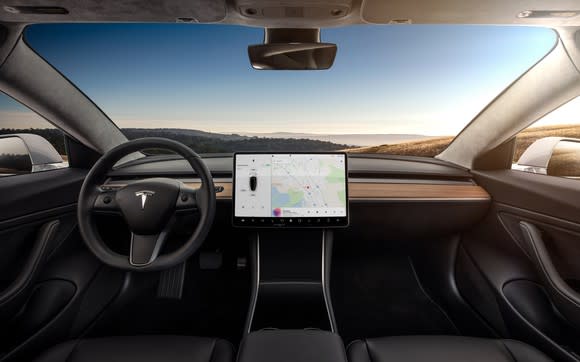5 Metrics Highlight Tesla, Inc.'s 2017
Tesla's (NASDAQ: TSLA) 2017 can be seen in both positive and negative light. On one hand, the electric-car company saw steep growth in vehicle sales, launched its long-awaited Model 3 to uncanny customer demand, and significantly ramped up its energy storage business. But Tesla also posted record negative free cash flow, totally whiffed on Model 3 production targets, and failed to deliver on a promised coast-to-coast autonomous drive.
For investors looking into Tesla's business and trying to decide whether it's a good investment, here's a look at the electric-car company's fundamental performance in 2017 across five different metrics.

Model X. Image source: Tesla.
Over 101,000 combined Model S and X deliveries
During 2017, one area where Tesla certainly delivered was combined Model S and X deliveries. Going into the year, the electric-car maker guided for 47,000 to 50,000 combined S and X deliveries during the first half of 2017. Total deliveries during this period were about 47,100. Then Tesla said it expected deliveries in the second half to "likely exceed deliveries in the first half of 2017." Second-half deliveries ended up coming in at about 54,000, bringing total Model S and X deliveries to just over 101,000 units, up 33% year over year.
46,500 Model X deliveries
Tesla's Model X SUV was Tesla's major catalyst for vehicle delivery growth in 2017. Tesla delivered about 46,500 Model X in 2017, up 84% from about 25,300 units in the year-ago quarter.
1,764 Model 3 deliveries
Where Tesla really missed the mark in 2017 was with its important Model 3 production ramp-up. Tesla only delivered 1,764 Model 3s during the year, despite management initially forecasting it would end the year producing an impressive 5,000 Model 3 units per week.

Model 3. Image source: Tesla.
Tesla is now expecting to achieve this target by the end of its second quarter.
These Model 3 deliveries brought total vehicle deliveries in 2017 to about 103,000, up 35% year over year.
55% organic revenue growth
Tesla's revenue in 2017 was up about 68% year over year. Excluding growth achieved through its acquisition of SolarCity in the fourth quarter of 2016, Tesla recorded 55% year-over-year organic revenue growth.
Most of this growth was driven by a 52% jump in automotive revenue, but Tesla's top-line growth also benefited from strong growth in energy storage systems revenue and "services and other" segment revenue.
Negative free cash flow of $3.5 billion
Readying Model 3 for mass production doesn't come cheap. In 2017, Tesla's capital expenditures were about $3.4 billion, up from $1.3 billion in 2016. This significant capital outlay was fueled primarily by Model 3 manufacturing equipment, Gigafactory construction and capacity increases, and new stores, service centers, and Superchargers to support its growing vehicle fleet.
Spending so heavily on its growth initiatives, Tesla's negative free cash flow worsened from negative $1.4 billion in 2016 to negative $3.5 billion in 2017.

Tesla factory. Image source: author.
For 2018, Tesla expects capital expenditures to be slightly more than in 2017. So, investors should look for Model 3 production and deliveries to soar, helping improve Tesla's worrisome negative free cash flow situation.
Despite its strong vehicle sales growth in 2017, these metrics put the spotlight on Tesla's heightened risk profile. Until Model 3 production ramps up to management's 5,000 units per week target, the automaker will likely continue burning through huge sums of cash. Of course, if Tesla's Model 3 production and deliveries really do take off as management believes they will, 2017 could prove to be a year of well-timed heavy investment in hindsight.
More From The Motley Fool
Daniel Sparks owns shares of Tesla. The Motley Fool owns shares of and recommends Tesla. The Motley Fool has a disclosure policy.

 Yahoo Finance
Yahoo Finance 